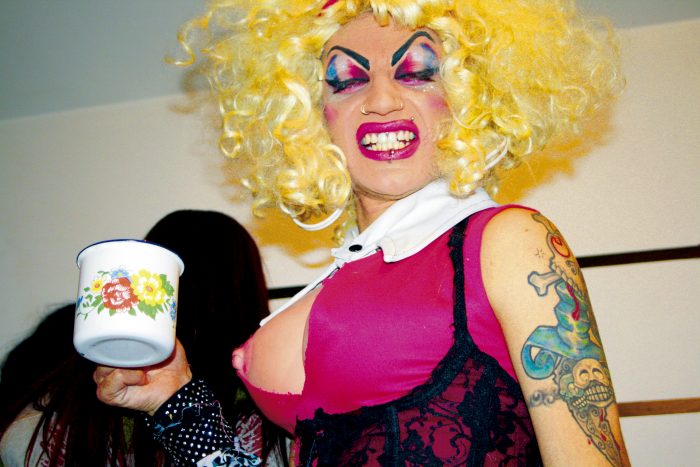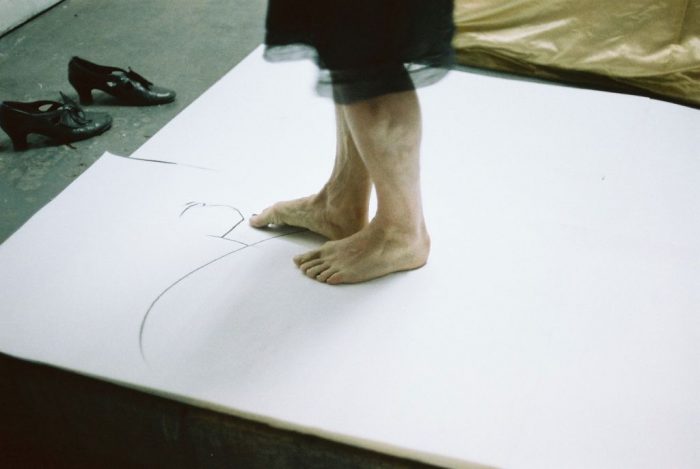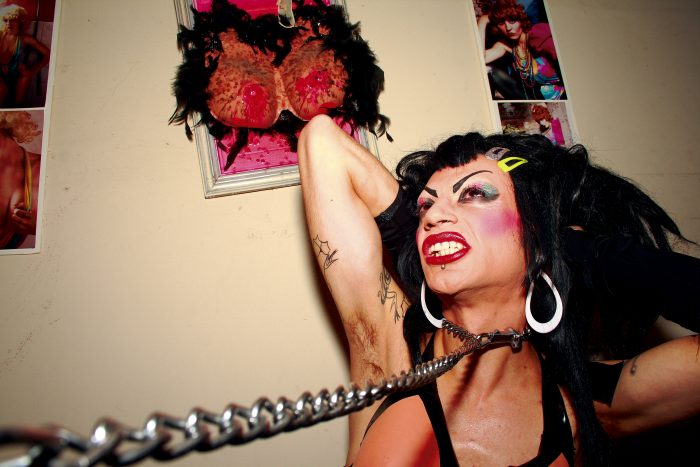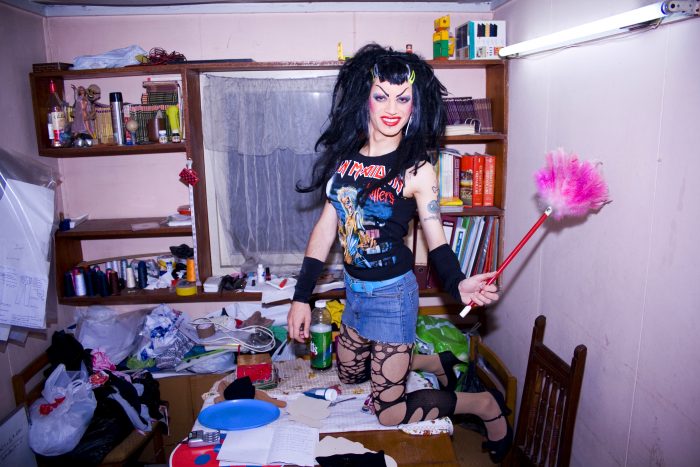
21.05.2020
Thinking about the implications of the intimacy that confinement brings, researcher and curator aliwen proposes a critical reading of the normativity inside the house based on the analysis of two performance artists, Lorenza Böttner and Hija de Perra, who “kuirized” the private to claim their dissident existence.

Much of the recent literature on art has acquired a celebratory tone when speaking about the protests of kuir bodies in public space.[1] The boom of the eighties carried with it the legacy of AIDS, and suddenly the nineties ceased to be radical. That silly decade riddled with consumer waste assumed the solemnity of the neoconceptual afterglow, and the archives of the transgressive experiences of kuir artists began to be mined, filtered through the “abc’s” that characterized the end of the last century: the amateur, the banal, and the commonplace. However, many of the specialists who wear our colors by day have the advantageous option of taking them off again when they return home. But what happens for those who simply can’t?
The situation has become more serious in light of the physical distancing the COVID-19 pandemic has necessitated. How can you quarantine when you don’t have a roof over your head, your own room, or a safe space with Wi-Fi? Why should someone have to live through this period without the material and emotional support they need to survive—without access to education or to “universal,” antipatriarchal health services? This phenomenon is especially difficult for those who belong to the LGTBIAK+ [2] community because they are much more likely to be ostracized from their families, to be discriminated against in bureaucratic contexts, and to have more precarious health situations. Thirty-eight percent of Chilean sexo-dissidents between the ages of 11 and 59 reported an increase in lesbo-, homo-, and trans*-phobic encounters in their homes and neighborhoods following the appearance of coronavirus; this dramatic change has been attributed to the increased amount of time that we are required to spend at home as well as to the obstacles that the newly imposed precautionary health restrictions have posed to the reporting of incidents of abuse.[3]
I will explore the work of two performers from Chile with an interest in the ways in which both gave new meaning to the oppressive prison that the space of confinement can be for dissidents.
While political demonstrations in public spaces have constituted an integral aspect of our history of resistance, COVID-19 presents an opportunity for us to take a fresh look at the need for the safety provided by private spaces in a life of dissent; we require a politicized reading of the closed space of confinement as an extimate space for the performance of kuir[4] living. “Extimacy” is a psychoanalytic concept that describes how in the innermost core of subjectivity is sheltered the very Other which is external to it. It is a presence which blurs the dividing line between the “inside” and the “outside.” This alterity constitutive of the I is analogous as much to the marginal position which sexo-dissident intimacy occupies within the space created by hetero-winka-cis-patriarchal institutions as it is to the revolutionary commitment which has allowed us to survive. Considering the parallels that exist between the concepts of extimacy and the kuir brings us to the impact of another pandemic—that of the HIV/AIDS virus—and its reflection in art at the end of the eighties.[5]
I will explore the work of two performers from Chile with an interest in the ways in which both gave new meaning to the oppressive prison that the space of confinement can be for dissidents. Artists whose bodies, trespassed upon by the retrovirus HIV, found platforms within private space to produce viral images charged with erotic intimacy and anti-normative performativity. Returning to and rearticulating these sculptural actions is to engage in a kuir temporality, to live in the present with the grief for those who have disappeared due to AIDS, and, in this way, to unfold new utopias where the rights of communities of sex- and gender-nonconforming minorities become inalienable ethical rights.

Lorenza Böttner Oeding was born on March 6, 1959 to a German mother and a Chilean father also of German descent. She was raised with the name Ernst Lorenz in Punta Arenas, one of the most southerly parts of Chile. At the age of eight, an accident while climbing up an electric pole in order to look at a bird’s nest resulted in serious burns to her hands and arms, which in turn led to a series of partial amputations over the course of the next several years. Little by little, gangrene spread up her arms due to the lack of adequate and available medical care. Finally, in 1969 the family decided to travel to Germany in search of treatment.
According to a testimony Lorenza submitted to the children’s comic Mampato in November 1973, it was after her accident that her artistic streak began to flourish, proving that for Lorenza, her “disability” would never reduce her to the role of the victim, but rather would become a transformative power in her life. She wrote, “Little by little I learned how to use a pencil with my mouth and I was still in the hospital when I first attempted to draw. I believe that when one loses something, they must look for a way to replace that thing. All is not lost.”[7] Partially due to the limited medical options in Chile, and partially due to the hostile political situation that seized the country after the September 11 coup in 1973, Lorenza and her mother Irene emigrated to Germany for good shortly after Lorenza submitted this note to the magazine, taking advantage of Irene’s dual citizenship. It was at this same time that both Lorenza’s arms where amputated up to her shoulders.
After arriving in Munich, Irene worked cleaning the same sanatorium where Lorenza received treatment until 1977. Later, Lorenza would enroll in the School of Art and Design in Kassel from 1978 and 1984. It is likely that during this period Lorenza engaged in sex work in order to help support her nuclear family. What is certain is that the developing artist took the name Lorenza towards the eighties at the same time that she was developing an interdisciplinary art practice that brought together elements of drawing, photography, dance, performance, painting, and sometimes sculpture to produce self-referential images that moved between techniques of representation—employing traces of both her mouth and feet—and movement, and which questioned biomedically-normalized conceptions of the “disabled” body.
In 1989 the Chilean artist Mario Soro arrived in West Berlin to participate in the exhibition “Plastic Surgery: Contemporary Conceptual Art in Chile 1980-1989,” which opened two months before the fall of the Berlin Wall.[8] Following this, Mario visited his cousin Karin Soro Korn in Frankfurt, who told him about an artist-relative who lived in Munich. Deciding to take advantage of his trip, Soro traveled to meet Lorenza. The friendship they forged during that first meeting inspired them to plan a trip to Chile for Lorenza and Irene later that year. At the time, Mario worked at the Bucci Gallery, located on the Calle Huérfanos in the center of Santiago. Opened in 1975, it wasn’t until the mid-eighties that the gallery would become a landmark for the culture of opposition against the dictatorship, with a program that included polemical exhibitions of neo-avant-garde art as well as tocatas panki (punk jam sessions).

The aesthetic of kuir clubs penetrates the private world, where we see how a boy abused at the hands of social normativity transforms himself into the dirty doll of his dreams.
The naked Lorenza is a smooth reversal of the Western pictorial tradition that we tend to associate with those great narratives of art history which privilege a masculine visuality and the normalized “healthy” body. What would happen if the iconic classical image of the chaste Venus were to misplace its arms, like the Venus de Milo? Lorenza presents her body with functional diversity, not as pathological or undesirable, but rather as charged with a strong sensuality; she performs a striptease that does not surrender entirely to vision nor to the preconceived ideas of the spectator, instead dissolving back into the silhouette effected by the chiaroscuro of her fragile armor of cloth. The exteriority of the window opening out onto the commercial avenue and the intimate space on the other side of the screen come together in the vulnerability of the naked body in motion. An iconoclastic act of courtship, in whose sway vitality transmutes.
Lorenza Böttner died of HIV-related complications in Munich in January 1994.

la perra del living[9]
Wally Pérez Peñaloza was born on January 7, 1980. The director Wincy Oyarce—Wally’s friend and collaborator—recalls that Wally began to develop his transvestite[10] personality over the course of several vacations at the beginning of the 2000s, inspired the aesthetic of the music video for Madonna’s song Frozen (1998) and interested in exploring a darki (goth) femininity that flirted with a zoomorphic imaginary.
It is quite common for the sexual agency of women and kuir to be denigrated in anthropocentric Western cultures through the use of insults equating them to animals like dogs and birds (both of which have been subjected to different degrees of domestication and slavery at the hands of humans), reduced to an infrahuman status through the speciesist logic implicit in the hierarchization of species. Within the hetero-winka-cis patriarchy, the insult “son/daughter of a bitch” is a way of challenging the legitimacy of the lineage of the person for whom the insult is intended, implying that they are a bastard—a maximum sentence that often resulted in ostracization in the scheme of patrilineal transmission of power, in which parentage is tracked with great exactitude in order to calculate social lineage and racial capital. To appropriate this insult for oneself is a kuir reinterpretation that questions the values of obligatory heterosexuality, racial legitimacy, and ideas of health that have been sanitized through baroque excess into a monstrous future: dissident, battered, viral.
Wally’s character of Hija de Perra [Daughter of a Bitch] crystallized after 2002. She appeared at underground parties wearing her characteristic makeup with pronounced eyebrows, unkempt wigs, and prosthetic breasts and vulva. Hija de Perra and the photographer Lorena “Lagata” Ormeño met each other in 2005 at Femfest, a music festival founded the year before by girl bands critical of the lack of opportunities for women in music. Lorena recalls that la Perra offered to be a performer at the event and ended up filling the entire Femfest set with pads stained with fake blood. In 2007 Ormeño began to systematically document her friend la Perra in underground parties in Santiago[11] and Valparaíso. The series El glamour de la basura: Hija de Perra [The Glamor of Trash: Hija de Perra] was born out of this project, which Lorena completed two years later when she presented the work as her thesis for her undergraduate photography degree at the Instituto Profesional de Arte y Comunicación ARCOS. The same series was shown from September 9 to October 13, 2009, in the Hall del Centro Arte Alameda, an experimental movie theater and center for countercultural gatherings.[12]

The series was divided into three sections: “Perra’s Shows,” “Perra and Friends,” “Perra at Home.” In the last section, Lorena photographed the performer inside her home located in an outer neighborhood of San Miguel; it is a series that allows us to enter inside la Perra’s daily life in a vote of artistic complicity. La Perra’s baroque appearance in these images makes us wonder: Are we to believe that the performer always dressed up in this way, even while in her own home? But this question loses relevance when we consider that the joint artistic work of the photographer and the transvestite produces a critique of the idea of a stable identity. In these portraits, the character of la Perra merges with Wally’s life and vice versa, channeling a transvestite genealogy of Abya Yala in which the cosmetics and prosthetics of gender are indivisible from the creative rite activated by dissidence. This twisting genealogy—found among the ceramic vestiges of the Moche culture; passed down through the machi weye of the Mapuche culture; and derived from the performance of the Yeguas del Apocalipsis—contrasts sharply with the professionalized entrepreneurship of the drag queen pro-R*Paul’s Dr*g R*ce (2009-) in the Global North, where transgressions of gender are deemed consumer goods to be validated by the mainstream and where they occur on a stage, under the condition that the performers fulfill the expectations of a homonormative binary masculinity that hides behind-the-scenes.[13]
One of the photographs from the aforementioned section is called Perra del Living (2008). The photograph was taken in the performer’s living room, with la Perra appearing on her knees atop a table cluttered with object—bottles, notebooks, silverware, tablecloths, tights. In the background, one catches sight of a simple home with old walls, strewn with plastic bags filled with pieces of fabric, sewing patterns, cables, adhesive tape; on the shelves we see a string, nail polish, a sign, keepsakes, files, books, in the midst of which we can make out a window hung with a dusty lace curtain. Like the doll clutched in the arms of a stuffed monkey standing between an empty bottle of Chillán aguardiente and a bottle of bug spray in the upper left-hand corner of the shelf, we see the profile of a thrasher B*rbie of human proportions, leaning towards the right of the composition but looking straight at the camera: la Perra in black stilettos, ripped tights, denim mini-skirt, Iron Maiden sweatshirt, and unkempt long black hair.
The curatorial text which accompanied the exhibition of the series argued that the performer “reveals characters as mirrors of society, exaggerating the roles society imposes and making them grotesquely anti-aesthetic, linking them to kitsch and the abject, as well as to humor and the bad imitation.” The pink feather duster, the punctum[14] of the well-examined photograph, can be understood as an ironic reference to the “imposed roles” of unpaid domestic labor which fall to women in our society. But the representation of the housewife in this photograph is a “bad imitation” as much for la Perra’s raucous aesthetic (which contrasts sharply with the idea of utilitarian labor) as for the fact that this quotidian object of housework ends up highlighting—thanks to the frozen temporality of the photograph—the garishness and extravagance of the materiality of its feathers. The aesthetic of kuir clubs penetrates the private world, where we see how a boy abused at the hands of social normativity transforms himself into the dirty doll of his dreams.
Wally “Hija de Perra” Pérez died of HIV-related complications on August 25, 2014.
–
The English translation of this text was done by Chloé Wilcox.
I would like to thank Diego del Valle Ríos for inviting me to participate in this issue of Terremoto, for his constant kindness, and for his kuir provocations. I would also like to thank Lorena Ormeño, Wincy Oyarce, and Mario Soro, who welcomed me to share in their intimate memories, including me both through oral story-telling and by allowing me to explore their personal archives to string to together the story of these rebellious figures.
This acronym refers to Lesbians, Gays, Trans*, Bisexuals, Intersexuals, Asexuals/Allies, Kuirs and other non-hegemonic sexes and genders. Several different acronyms, including TLGB or LGBTI, for example, are used to describe to this community depending on the region of Abya Yala. “Abya Yala” is a term used by some indigenous peoples of North and South America to refer to both continents, as an ideological move away from using the names imposed on the region by colonizing powers.
“LGBTI people in Chile: 38% reports an increment in homo/transphobia at their homes and neighborhoods after COVID” in MOVILH, April 15, 2020:
Here I am invoking the sudaca (a sometimes derogatory term which means “South American,” but which here is deployed in an act of appropriation) and slang term for “queer,” a different mode of inscription within the turn to international identity-positivity, one that seeks to establish an alternate category for those kuir corporeities that have not been assimilated into discourses of biomedical binaries, nor by homonormativity “in which multiculturalism, with its flexible separation of sexual identities reduced to particularities, returns these easily assimilable identities back to the neoliberal market of pleasures and desires that depoliticizes activist struggles with its menu of consumer choices” [Translator’s translation]. For more, see Nelly Richard, “Realismo socialista” Torcida, May 6, 2020,
I am picking up the thread of reflections of one of the performers whom I visited, Hija de Perra, who defined herself in 2012 at the Third Fair of Queer Art in Mendoza as “a new Latina mestiza from South America who never expected to be taxonomically identified as queer, but who now fits perfectly into this classification in the eyes of gender theorists and according to the new knowledge, studies, and reflections that have come from the North, which proposes this or that botanical name for my extravagant species labeled a minority,” quoted in Hija de Perra, “Interpretaciones inmundas de cómo la Teoría queer coloniza nuestro contexto sudaca…” en Punto Género, no. 4, (December 2014): 11.
With this point, I hope to establish a dialogue with the art historian Élisabeth Lebovici, who returns to the concept of “extimacy” to articulate her reading of the intersections between the artistic practices and activism surrounding HIV/AIDS at the end of the eighties and throughout the nineties. She writes, “The notion of intimacy (as well as the Lacanian concept of “extimacy”) has become part of cultural space. It is to this that the proliferation of “solo” dances and the performances of the I attest. […] It is to this that the intimist images—associated with scrupulous examinations of the quotidian, of the banal—attest, seething, and festering in sculptural creation, in the movies. […] All these modalities have set a scene of the intimate, as if it were also necessary to break with the supposed neutrality of the space of representation and draw a new configuration, one where the limits between interior and exterior, between the private sphere and public space, become even more porous like that porosity which seropositivity and the epidemic produced.” Élisabeth Lebovici, “Estar allí. Un recorrido muy parcial por las exposiciones europeas y el activismo contra el sida a finales del siglo XX,” in Sida (MACBA: Barcelona, 2020), 34. Translator’s translation.
“la walkiria trunca” roughly translates to “the armless valkyrie.”
No author, “Ernst Böttner, un muchacho ejemplar” Mampato 198, November 7, 1973: 42, cited in Ángeles Mateo del Pino, “Subjetividad transtullida. El cuerpo/corpus de Lorenza Böttner” Anclajes 23, no. 3 (2019): 37-57.
See Francisca García, “Berlín, ‘Cirugía plástica’: historia de una controversia,” in Ensayos de artes visuales, vol. 7, “El arte chileno más allá de sus fronteras” (Santiago, Chile: Centro de Documentación de las Artes Visuales, 2019, 28.
Roughly translated, this means “the bitch of the living room.”
Many radical gender-variant activists and thinkers of Abya Yala insist on using the word “transvestite” to define our gender-nonconformity, though this term is considered derogatory and outdated in the Global North. This is a strategy of appropriating an insult with which we have been stigmatized in our own context (in the same way that “queer” was used in the anglophone world), while also decolonizing the normalized North-South transference of activist discourse and academic theory by choosing a term that makes globalized audiences uncomfortable while continuing to make sense within our own history of suffering and political memory.
Some of these photographs were taken at the Cabaret Chiquitibum festival, organized by Denisse “Suelta” Castillo, Wincy Oyarce, Wally Pérez, and Matilde “Perdida” Plaza, among others. This festival was begun in 2002 as a private event where the group of friends could perform for each other. That same year it became a public event located on land belonging to a chicken refrigeration plant near the Pan-American highway in San Miguel where Wally lived. It was here that Hija de Perra made her first public debut. The event was very popular, so the group formed an alliance with another important underground party from the period called Bizarre, which took place on the Calle Fanor Velasco in the center of Santiago. The Chiquitibum in San Miguel came to an end in 2007, but continued on in other locations, organizing themselves as the Cabaret Chiquitibum Collective or Company until approximately 2010. It is worth mentioning that the photographer Lorena “Lagata” Ormeño continued to collaborate with La Perra on different projects throughout her life. Among many projects, she worked as the photographer for the music videos for Obey My Orders with the singer Felipink and Sexy puta by the Tíos Bizarros, and documented street protests like that of the XIII Marcha por la Diversidad Sexual, all in 2011.
The Centro Arte Alameda was recently burned to the ground when police threw more than 70 tear gas bombs at the building and its surroundings on December 27, 2019, a day of many public protests against the increasing precarity of life under neoliberalism in Chile.
This trend can be seen reflected in the sayings of the businessman behind the character RuPaul, who refuses to allow people who were assigned a female gender at birth to participate in the televised drag competition Dr*g R*ce, saying, “Drag loses its sense of danger and its sense of irony once it’s not men doing it because at its core it’s a social statement and a big f-you to male-dominated culture. So for men to do it, it’s really punk rock, because it’s a real rejection of masculinity.” This statement further demonstrates that barring biological women from the show contradicts the idea that Dr*g R*ce is an affront to “male-dominated culture,” which is further clarified when he explains that the same fate awaits transgender women. He states, “You can identify as a woman and say you’re transitioning, but it changes once you start changing your body. It takes on a different thing; it changes the whole concept of what we’re doing. We’ve had some girls who’ve had some injections in the face and maybe a little bit in the butt here and there, but they haven’t transitioned.” Decca Aitkenhead, “RuPaul: ‘Drag is a big f-you to male-dominated culture’” The Guardian, March 3, 2018:
It was the post-structuralist Roland Barthes who coined the term “punctum” to designate that “sting, speck, cut, little hole—and also a cast of the dice. A photograph’s punctum is that accident which pricks me (but also bruises me, is poignant to me).” Roland Barthes, Camera Lucida, trans. Richard Howard (New York: Hill and Wang, 1980 [2010]), 59.
Comments
There are no coments available.